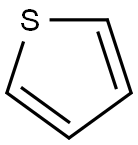-
外観
無色〜わずかにうすい褐色又はわずかにうすい赤紫色, 澄明の液体
-
性質
チオフェンは物理的な特性や化学的な反応性は、と良く似ています。そのため、ベンゼンに似た匂いを発します。チオフェンは無色の液体であり、融点は−38°C、沸点は84°Cです。
ベンゼン、エーテル、などの溶媒とは、任意の割合で混合します。ただし、水には不溶です。チオフェンは850℃に加熱しても分解せず、熱的に安定しています。
-
溶解性
水に不溶, エタノールに可溶, エーテルに易溶。エタノール及びアセトンに極めて溶けやすく、水にほとんど溶けない。
-
解説
チオフェンとは、硫黄を環内に持つ五員環複素環式化合物の1つです。
チオフェンという名前は、硫黄を示す接頭語のチオ (英: thio) とを示すフェン (英: phene) を合わせて命名されています。チオール (英: thiole) と呼ばれることもありますが、チオール (英: thiol) と紛らわしいため推奨されていません。
チオフェンは、タールや石炭ガス中に少量含まれています。また、工業的には、高温環境下でブタンと硫黄を脱水素閉環反応により合成されます。
-
用途
ベンゼンと同様の溶剤(高温及び低温に適する)、樹脂、染料、医薬品。
-
応用
医薬品、農薬、染料などには、部分構造にチオフェンを有する化成品が多いです。チオフェンを含んだ重合体は、ポリチオフェンと呼びます。
ポリチオフェンの具体例は、ポリチオフェンビニレンやポリ (3-アルキルチオフェン) などです。ポリチオフェン類は伝導性を持っているため、有機金属や有機半導体の研究対象として注目されています。
参考文献
-
構造
チオフェンは硫黄を含んだ複素環式化合物で、化学式はC4H4Sです。フラン (英: furan) の酸素原子が、硫黄原子に置き換わった5員環構造を持っています。チオフェンの分子量は84.14、比重は1.051g/mLです。
化合物の命名の際に、チオフェン環を置換基として扱う場合には、チエニル基 (英: thienyl group) と呼びます。
-
合成
触媒を用いて、 (CS2) とフランやメチルフランを反応させて、チオフェンを得ることが可能です。実験室では、コハク酸ナトリウムと五硫化二リン (P2S5) またはと三硫化二リン (P2S3) との組み合わせで反応させると生成します。
-
化学的特性
Thiophene is a colourless to pale yellow liquid that has an odor similar to benzene. It is a heterocyclic compound with a five-membered ring containing four carbon atoms and one sulfur atom. The ring system is also known as a thienyl ring. It occurs as an impurity in commercial benzene and is used as a solvent and in organic syntheses.
-
物理的性質
Clear, colorless liquid with an aromatic odor resembling benzene. An odor threshold concentration
of 0.056 ppbv was reported by Nagata and Takeuchi (1990).
-
使用
Thiophene is used as a building block of various organic molecules and pharmaceuticals providing functional properties.
-
定義
ChEBI: Thiophene is a monocyclic heteroarene that is furan in which the oxygen atom is replaced by a sulfur. It has a role as a non-polar solvent. It is a mancude organic heteromonocyclic parent, a member of thiophenes, a monocyclic heteroarene and a volatile organic compound.
-
調製方法
Thiophene is present in coal tar and is recovered in the benzene distillation fraction (up to about 0.5% of the benzene present). Its removal from benzene is accomplished by mixing with concentrated sulfuric acid, soluble thiophene sulfonic acid being formed. Thiophene gives a characteristic blue coloration with isatin in concentrated sulfuric acid. The basic nomenclature of the thiophene ring system and its derivatives is indicated by the following: the sulfur atom is number 1, positions 2 and 5 are equivalent in the parent ring, as are the 3 and 4 positions.
-
一般的な説明
Thiophene appears as a colorless liquid with an unpleasant odor. Insoluble in water and slightly denser than water. Flash point 30 °F. Vapors heavier than air. Irritates the skin, eyes, and mucous membranes. Used to make pharmaceuticals and dyes.
-
空気と水の反応
Highly flammable. Insoluble in water.
-
反応プロフィール
Thiophene reacts violently with strong oxidizing agents and concentrated nitric acid causing fire and explosion hazards [Handling Chemicals Safely 1980. p. 899]. A mixture of Thiophene and N-nitrosoacetanilide exploded at 0°C [Ber., 1887, 30, 367].
-
危険性
Flammable, dangerous fire risk.
-
健康ハザード
May cause toxic effects if inhaled or absorbed through skin. Inhalation or contact with material may irritate or burn skin and eyes. Fire will produce irritating, corrosive and/or toxic gases. Vapors may cause dizziness or suffocation. Runoff from fire control or dilution water may cause pollution.
-
火災危険
HIGHLY FLAMMABLE: Will be easily ignited by heat, sparks or flames. Vapors may form explosive mixtures with air. Vapors may travel to source of ignition and flash back. Most vapors are heavier than air. They will spread along ground and collect in low or confined areas (sewers, basements, tanks). Vapor explosion hazard indoors, outdoors or in sewers. Runoff to sewer may create fire or explosion hazard. Containers may explode when heated. Many liquids are lighter than water.
-
化学性质
独特の臭いを有し,化合物の骨格や置換基によっては色を呈する場合がある
-
使用用途
チオフェンは溶媒として用いられる他、染料・プラスチック・医農薬の原料としても利用されています。少数のチオフェンが重合したオリゴチオフェンとその機能性誘導体は、有機ELや有機電界効果トランジスタ、有機太陽電池などのハイテク用途として、幅広く使用可能です。
また、多数のチオフェンが連なった構造のポリチオフェンは、導電性高分子として使用されています。チオフェンを原料として合成される縮環チオフェンは、高性能なとして、高移動度トランジスタや有機薄膜太陽電池、有機ELなどの電子デバイスに欠かせない物資です。
-
定性反応
わずかなチオフェンを確認するための定性反応は、インドフェニン反応 (英: indophenine reaction) と呼ばれています。インドフェニンとは、イサチン2分子がチオフェン2分子で繋がった構造を有する化学式がC24H14N2O2S2の青色の色素です。
濃硫酸存在下でチオフェンとイサチン (英: Isatin) が反応すると、インドフェニンを生成して青色になります。また、ガスクロマトグラフィーなどの方法を用いても、チオフェンの同定は可能です。
-
反応選択性
ニトロ化、ハロゲン化、フリーデル・クラフツ反応 (英: Friedel–Crafts reaction) のような親電子置換反応は、チオフェンの2位に選択的に起きます。アルキルリチウムのような強塩基をチオフェンに作用させると、酸塩基反応が起こり、プロトンが引き抜かれたチエニルアニオンが生じます。
その一方で、チオフェンは芳香族性を持っているため、二重結合への付加反応は起こりにくいです。
-
安全性プロファイル
Poison by ingestion and
intraperitoneal routes. Mildly toxic by
inhalation and subcutaneous routes. A very
dangerous fire hazard when exposed to heat
or flame. Explosive reaction with N-nitrosoacetanilide.
Violent or explosive
reaction with nitric acid. Incompatible with
oxidizing materials. To fight fire, use foam,
CO2, dry chemical. When heated to
decomposition it emits highly toxic fumes of
SOx.
-
環境運命予測
Photolytic. A rate constant 9.70 x 10-12 cm3/molecule?sec was reported for the reaction of
thiophene and OH radicals in the atmosphere at room temperature (Atkinson, 1985). Thiophene
also reacts with NO3 radicals in the atmosphere at rate constants ranging from 3.2 x 10-14
(Atkinson et al., 1985) to 3.93 x 10-14 cm3/molecule?sec (Atkinson, 1991).
-
純化方法
The simplest purification procedure is to dry thiophen with solid KOH, or reflux it with sodium, and fractionally distil it through a glass-helices-packed column. More extensive treatments include an initial wash with aqueous HCl, then water, drying with CaSO4 or KOH, and passage through columns of activated silica gel or alumina. Fawcett and Rasmussen [J Am Chem Soc 67 1705 1945] washed thiophene successively with 7M HCl, 4M NaOH, and distilled water, dried with CaCl2 and fractionally distilled it. *Benzene was removed by fractional crystallisation by partial freezing, and the thiophene was degassed and sealed in Pyrex flasks. [Also a method is described for recovering the thiophene from the *benzene-enriched portion.] [Beilstein 17 H 29, 17 I 17, 17 II 35, 17 III/IV 234, 17/1 V 297.]



